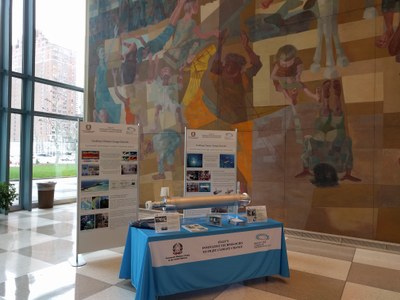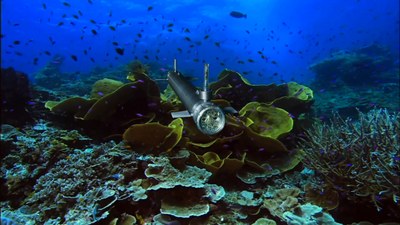Climate: At the UN headquarters advanced Italian-made technology to tackle climate change
14/4/2016
Swarms of submarine robots that can “dialogue” with each other, monitor sensitive data, control temperature and salinity, study currents and coastal erosion and issue a tsunami alert. The ENEA Technology Venus Swarm, based on submarine drones inspired by fish behavior, was presented to delegates from 120 Nations at the UN Headquarters in New York during the conference “Fighting Climate Change: Sharing Italy’s Innovative Technologies” organized by the Permanent Mission of Italy to the United Nations.
Swarms of submarine r obots that can “dialogue” with each other, monitor sensitive data, control temperature and salinity, study currents and coastal erosion and issue a tsunami alert.
obots that can “dialogue” with each other, monitor sensitive data, control temperature and salinity, study currents and coastal erosion and issue a tsunami alert.
The system, one of the six Italian-made advanced technologies designed to prevent and combat climate change, is called Venus Swarm and was developed at the ENEA Laboratories. It was presented to delegates from 120 Nations at the UN Headquarters in New York.
The initiative, that took place 10 days ahead of the signing of an Agreement reached at the COP21 Conference in Paris, was aimed at introducing highly innovative solutions to those Countries most threatened by rising temperatures, for instance small Pacific islands.
At the Conference “Fighting Climate Change: Sharing Italy’s Innovative Technologies” organized by the Permanent Mission of Italy to the United Nations at the UN Building, along with an example of the ENEA drones inspired by fish behavior, technologies by the CAE, Consorzio Venezia Nuova, ENEL green power, ENI and Telespazio/Finmeccanica were also on display.
A submarine web communicating with satellites
The ENEA Technology Venus Swarm, inspired by swarm behavior, was designed at the Laboratory “Distributed Intelligence and Robotics”, specialized in advanced mobile, terrestrial, submarine and aerial robotics. Robotic “fish” can monitor large areas of the sea and acquire sensitive data on acidity, salinity, temperature, speed and direction of currents and provide reliable and detailed data on local and global climate.
The particularly innovative communication system -in the process of being patented- combines acoustic and optical modems; each element of the submarine swarm acts in a coordinated fashion and communicates wirelessly, via a system using a combination of light and sound, at a speed never before attained in water.
The result is an actual submarine web able to communicate with satellites via a  surface transponder.
surface transponder.
“Thanks to integrable sensors, Venus Swarm can correlate thermal, geo-climatic and bioclimatic variations of water mass with surface atmospheric observations and, most importantly, acquire useful information rapidly and at low cost, to carry out timely interventions concerning health protection, tourism, fishery and pollution” Claudio Moriconi, Head of the ENEA Laboratory, explains. Its next task will be a climate monitoring mission to protect one of the most vulnerable areas in Italy, the Venice Lagoon. It was also proposed to the Consortium Venezia Nuova to protect Mose, the flood barrier system in Venice, consisting of rows of mobile gates.
ENEA and the fight against climate change
ENEA contributed to the Conference held at the UN headquarters in its role as a research institute committed to defining mitigation and adaptation strategies for climate change and as the Italian focal point for technology transfer to Developing Countries for the Convention on Climate Change.
Its role was also presented through illustrative panels on the causes and hazards of climate change, its impact on coastal areas and islands and the outcomes of a study conducted by the Climate Modelling and Impacts Laboratory at ENEA, indicating 33 coastal areas at risk of flooding due to rising global temperatures.
Watch the video: Robot-fish swarms against climate change
For more information
- ENEA Laboratory “Distributed Intelligence and Robotics”
- Fighting Climate Change: Sharing Italy’s Innovative Technologies
- Claudio Moriconi, Centro Ricerche Casaccia, claudio.moriconi@enea.it
